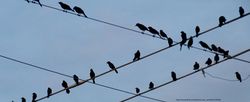ISSS608 2017-18 T3 Assign Lu Yanzhang
|
|
|
|
|
Overview
Mistford is a mid-size city located to the southwest of the Boonsong Lekagul Wildlife Preserve. The city has a small industrial area with four light-manufacturing endeavors. Mistford and the wildlife preserve are struggling with the possible endangerment of the Rose-Crested Blue Pipit, a locally loved bird. The bird’s nesting pairs seem to have decreased alarmingly, prompting an investigation last year implicating Kasios Office Furniture, a Mistford manufacturing firm. Since the initial investigation, the situation has evolved: Kasios insists that they have done nothing wrong! They assert that grad student Mitch Vogel and his professors are mere media-seekers trying to draw attention away from their lackadaisical research. Kasios presents itself as an extremely eco-friendly organization. They have launched their own very public investigation into the issues raised last year and are reporting very different results! It’s time to apply your visual analytics expertise to help illuminate the path to good science.
Mini-Challenge 3 Overview
Mitch Vogel left his work at Mistford College but has not forgotten the Rose-Crested Blue Pipit. Soon after arriving in the small town of Sulev in Northern Europe, Mitch started to see the telltale signs of Methylosmolene damage at the nearby Panteleimon Aviary Sanctuary. Mitch hears from local bird watchers that populations of the Greater Eurasian Red-Throated Pipit have been affected.
Since arriving in Sulev, Mitch also noticed that the local university’s office furniture was built in a nearby EuroKasios factory. Sure enough, EuroKasios is a subsidiary of Kasios International, Inc. – a huge multinational conglomerate that is also the parent company of Kasios Office Furniture back in Mitch’s hometown of Mistford. Mitch is immediately suspicious that EuroKasios is contaminating the aviary Sanctuary and endangering the Greater Eurasian Red-Throated Pipit. Worse yet, Mitch wonders if Kasios International may be contaminating pipit habitats around the world.
Mitch spends weeks reviewing press coverage of Kasios International and public statements made by the company’s CEO. Many of the articles tout the company’s environmentally friendly practices and even talk about recent scientific research that proves the safety of AGOC-3A, an environmentally friendly replacement for Methylosmolene. Mitch is skeptical that the company has halted production and use of Methylosmolene so he contacts the company and asks to meet with representatives from their environmental compliance division.
To his disappointment Mitch is not granted a meeting. Then Mitch receives an anonymous letter from someone who’s willing to help. A fellow pipit lover who works at Kasios International has gathered up a variety of company data and identified a suspicious group within the company. Attached to the letter Mitch receives is a USB drive with phone, email, meeting, and procurement records for Kasios International over the past 2 1/2 years. Mitch wonders if the fate of the Eurasian Pipit lies somewhere in that data. Mitch intends to put this data together to see if the problems with Kasios are much larger than he initially suspected.
Questions
Your task is to investigate the hydrology data from across the Preserve. You are given a map of the Preserve (with the same base as last year’s challenge), with named sampling sites indicated on the map (the names have local significance, but are just mnemonics for your study) You are also provided with readings from each sampling station over time for several different chemicals and water properties.
Questions:
- Characterize the past and most recent situation with respect to chemical contamination in the Boonsong Lekagul waterways. Do you see any trends of possible interest in this investigation?
- What anomalies do you find in the waterway samples dataset? How do these affect your analysis of potential problems to the environment? Is the Hydrology Department collecting sufficient data to understand the comprehensive situation across the Preserve? What changes would you propose to make in the sampling approach to best understand the situation?
- After reviewing the data, do any of your findings cause particular concern for the Pipit or other wildlife? Would you suggest any changes in the sampling strategy to better understand the waterways situation in the Preserve?
